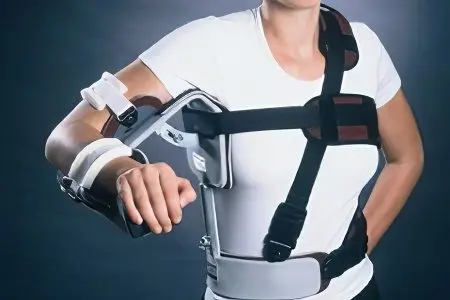Contents
Forearm fractures are the most common skeletal injury. According to statistics, the incidence of such injuries is 11% -30% of the total number of all closed fractures, and fractures of the diaphysis (body) of the bones of the forearm account for 53,5% of injuries to the bones of the upper extremities. An elderly person, a young person, and a child can get such an injury.
A bit of anatomy. The forearm is formed on the basis of two bones: the ulna and the radius. They are connected to each other by an interosseous membrane. Determining the location of these bones is simple: the ulna runs along the side of the little finger, and the radius is on the opposite side, where the thumb is located. One bone or both can break. The severity of the fracture and its treatment directly depends on which part of the bones of the forearm is damaged: the upper third, middle or lower.
Symptoms of a fracture of the bones of the forearm

The signs of this injury depend on the type of fracture encountered.
Fracture of the body of the ulna. Human movements are limited. There is deformity and swelling. Squeezing and probing the forearm causes severe pain.
Fracture of the radius. The forearm is deformed, the patient experiences sharp pains during palpation of the affected area, there is mobility of fragments. The person cannot actively rotate the forearm.
Fracture of the diaphysis of both bones. Widespread damage, almost always accompanied by displacement of bone fragments. The shortening and deformity of the forearm is clearly expressed. Usually, the injured person holds the injured limb with a healthy hand. Probing, lateral compression of the forearm causes intense pain throughout the entire length with increased pain at the fracture site. Fragment mobility is observed.
Fracture of the radius in a typical location. This type of injury is common in older women. The wrist region of the forearm is edematous. Visible deformation. Axial loading and probing causes severe pain. There may be a violation of sensitivity in the fourth finger of the hand, which indicates concomitant damage to the nerve branches.
Common Causes of a Forearm Fracture
You can break the bones of the forearm due to:
falling on the upper limb bent at the elbow or hitting this area;
direct blow to the forearm;
falling on a straight arm;
protection from a blow with a bent and raised forearm;
falling on the arm, leaning on the palm, or rarely, on the back of the hand;
sharp angular deformity of the forearm.
Diagnostics
To make a diagnosis, a doctor needs a clinical examination (external examination, probing the site of injury) and the results of an X-ray examination.
Treatment of fracture of the bones of the forearm
With an isolated diaphyseal fracture with displacement of the ulna, as well as the radius, treatment begins with reposition. This procedure is necessary for all types of displaced fractures. Its detailed description will be below.
When the reposition is carried out, a plaster splint is applied to the bent forearm of the patient, which should capture the areas of the wrist and elbow joints. The period of immobilization for a fracture of the ulna is 4-6 weeks, the radius – from five to six weeks.
Treatment of a fracture of the forearm with displacement of bone fragments is still one of the most difficult tasks of modern traumatology. Simultaneous reposition with such localization of the fracture is extremely difficult. It is even more difficult to keep bone fragments in the correct position for a long time.
Reposition begins with the study of radiographs. It can be performed manually or with the help of special devices and is performed under local anesthesia.
For rotational installation of fragments, stretching is performed, then the surgeon manually matches the ends of the broken bones. After, without weakening the traction and in the position achieved by reposition, a splint is applied to the damaged area. X-rays are taken to check the results. If the reposition is successful, then the bandage is converted into a circular one.
If the patient has massive edema, the splint remains until it disappears. When the edema has subsided, the patient needs to take a control x-ray to prevent re-displacement of bone fragments. After that, you can apply a plaster circular bandage for 10-12 days.
Starting from the second day, the patient should move his fingers, and on the 3-4th day – the shoulder joint. In addition, the patient must learn to perform rhythmic relaxation and muscle tension of the forearm, hidden by a plaster cast.
At the end of the immobilization period, the plaster cast is removed and the patient is prescribed therapeutic exercises and physiotherapy. The average recovery time is 12-14 weeks.
However, in the overwhelming majority of cases, doctors resort to surgical treatment of such fractures, since the elimination of all primary displacements and the prevention of secondary ones often fail. The problem is that, due to the tension of the interosseous membrane, fragments of the ulna and radius bones are approaching.
Operative therapy consists in carrying out open reposition and osteosynthesis. The operation is best done on the second or fourth day after the injury. It is performed under general anesthesia.
Access to the bones is provided by two independent incisions. First, surgery is performed on the ulna. The ends of its fragments are isolated and set, then osteosynthesis is performed using metal fixators (metal plates, rods, knitting needles, wire sutures, etc.). Then a similar manipulation is performed on the radius.
At the end of the osteosynthesis, a plaster cast is applied to the limb bent at a right angle. Usually the period of immobilization is 10-12 weeks, sometimes it can be extended.
After the bandage is removed, the patient is prescribed gymnastics, massage, physiotherapy and mechanotherapy. It takes 14 to 18 weeks to recover from work.









